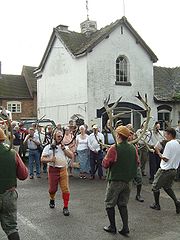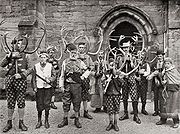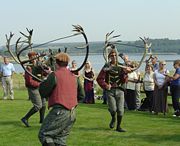
Abbots Bromley Horn Dance
Encyclopedia

Folk dance
The term folk dance describes dances that share some or all of the following attributes:*They are dances performed at social functions by people with little or no professional training, often to traditional music or music based on traditional music....
involving reindeer
Reindeer
The reindeer , also known as the caribou in North America, is a deer from the Arctic and Subarctic, including both resident and migratory populations. While overall widespread and numerous, some of its subspecies are rare and one has already gone extinct.Reindeer vary considerably in color and size...
antlers and a hobby horse
Hobby horse
The term hobby horse is used, principally by folklorists, to refer to the costumed characters that feature in some traditional seasonal customs, processions and similar observances around the world. They are particularly associated with May Day celebrations, Mummers Plays and the Morris dance in...
that takes place each year in Abbots Bromley
Abbots Bromley
Abbots Bromley is a village in Staffordshire, England. It is famous for the annual Abbots Bromley Horn Dance. It is also the home of one of the Woodard Schools, Abbots Bromley School for Girls...
, a small village in Staffordshire
Staffordshire
Staffordshire is a landlocked county in the West Midlands region of England. For Eurostat purposes, the county is a NUTS 3 region and is one of four counties or unitary districts that comprise the "Shropshire and Staffordshire" NUTS 2 region. Part of the National Forest lies within its borders...
, England.
Origins
There are no recorded references to the horn dance prior to Robert PlotRobert Plot
Robert Plot was an English naturalist, first Professor of Chemistry at the University of Oxford, and the first keeper of the Ashmolean Museum....
's Natural History of Staffordshire, written in 1686. However, there is a record of the hobby horse being used in Abbots Bromley as early as 1532, and it is possible that the horn dance component of the custom was also present at that time but not commented upon by the writer. A carbon analysis
Radiocarbon dating
Radiocarbon dating is a radiometric dating method that uses the naturally occurring radioisotope carbon-14 to estimate the age of carbon-bearing materials up to about 58,000 to 62,000 years. Raw, i.e. uncalibrated, radiocarbon ages are usually reported in radiocarbon years "Before Present" ,...
discovered that the antlers used in the dance date to the 11th century - though these may well have replaced an even older set. According to some, the use of antlers suggests an Anglo-Saxon
Anglo-Saxons
Anglo-Saxon is a term used by historians to designate the Germanic tribes who invaded and settled the south and east of Great Britain beginning in the early 5th century AD, and the period from their creation of the English nation to the Norman conquest. The Anglo-Saxon Era denotes the period of...
origin along with other native Anglo-Saxon traditions that have survived into modern times in various forms. It has been speculated, for example, that the dance originated in the pagan period and was connected with the ruling dynasty of Mercia
Mercia
Mercia was one of the kingdoms of the Anglo-Saxon Heptarchy. It was centred on the valley of the River Trent and its tributaries in the region now known as the English Midlands...
, based some 15 miles away at Tamworth
Tamworth
Tamworth is a town and local government district in Staffordshire, England, located north-east of Birmingham city centre and north-west of London. The town takes its name from the River Tame, which flows through the town, as does the River Anker...
, who owned extensive hunting lands in Needwood Forest
Needwood Forest
Needwood Forest was a large area of ancient woodland in Staffordshire which was largely lost at the end of the 18th century.-History:Needwood Forest was a chase or royal forest given to Henry III's son Edmund Crouchback, 1st Earl of Lancaster, in 1266...
and Cannock Chase
Cannock Chase
Cannock Chase is a mixed area of countryside in the county of Staffordshire, England. The area has been designated as the Cannock Chase Area of Outstanding Natural Beauty. The Chase gives its name to the Cannock Chase local government district....
surrounding Abbots Bromley. On this theory, the royal forester would have organised sympathetic magic
Sympathetic magic
Sympathetic magic, also known as imitative magic, is a type of magic based on imitation or correspondence.-Similarity and contagion:The theory of sympathetic magic was first developed by Sir James George Frazer in The Golden Bough...
rituals to ensure a plentiful catch each year, a tradition that survived into Christian times and gradually came to be seen as affirming the villagers' hunting rights. Even when the lands were granted to Burton Abbey in 1004 a forester would still needed to have been employed, and by the 16th century, when the abbey was dissolved, this hereditary position bore the title "Forester of Bentylee" (Bentylee being the wooded area of the parish). From then until the 19th century the dance remained the traditional prerogative of the Bentley family, eventually passing to the Fowell family in 1914 through a marriage alliance. The Fowells continue to run it to this day.
Such an ancient origin for the dance has been doubted by some folklorists, who point out that while the reindeer antlers date to the 11th century, reindeer were long since extinct in England and Wales (and probably Scotland), and there is no evidence that any domestic reindeer herds remained at that time. Therefore, even more confusingly, the antlers must have been imported from Scandinavia at some point between the 11th and 17th centuries. This fact may lend weight to the theory that the custom originally began with only a hobby horse, and the horn dance component was added later, explaining why only the former was mentioned by 16th century sources.
The dance was, like similar events throughout the country, temporarily discontinued during the Commonwealth
Commonwealth of England
The Commonwealth of England was the republic which ruled first England, and then Ireland and Scotland from 1649 to 1660. Between 1653–1659 it was known as the Commonwealth of England, Scotland and Ireland...
years. Prior to this, according to Robert Plot, it was performed on Christmas Day
Christmas
Christmas or Christmas Day is an annual holiday generally celebrated on December 25 by billions of people around the world. It is a Christian feast that commemorates the birth of Jesus Christ, liturgically closing the Advent season and initiating the season of Christmastide, which lasts twelve days...
, New Year's Day
New Year's Day
New Year's Day is observed on January 1, the first day of the year on the modern Gregorian calendar as well as the Julian calendar used in ancient Rome...
and Twelfth Day
Twelfth Day
Twelfth Day is the twelfth and last day of the traditional Twelve Days of Christmas which follow Christmas Day. In western Christianity it falls on 6 January, which is also the feast of the Epiphany....
, in addition to the local Wakes Monday
Wakes week
The wakes week is a holiday period in parts of England and Scotland.- History :Wakes were originally religious festivals that commemorated church dedications...
- though upon its revival in 1660 it was confined to the latter alone.
Event
The Horn Dance attracts a large number of visitors to the village. As well as the dance itself, Wakes Monday sees a Fair on the village green; Morris dancingMorris dance
Morris dance is a form of English folk dance usually accompanied by music. It is based on rhythmic stepping and the execution of choreographed figures by a group of dancers. Implements such as sticks, swords, handkerchiefs and bells may also be wielded by the dancers...
; and numerous other attractions. The right to hold this Fair was granted to the village in 1221.
Date and schedule of performance
The Horn Dance takes place on Wakes Monday, the day following Wakes Sunday, which is the first Sunday after 4 September. In practice, this means that it is the Monday dated between 6 September and 12 September (inclusive).The dance starts at 08:00 with a service of blessing in St Nicholas Church, where the horns are housed. The dance begins on the village green, then passes out of the village - but not out of the Parish - to Blithfield Hall
Blithfield Hall
Blithfield Hall , is a privately owned Grade I listed country house in Staffordshire, England, situated some east of Stafford, southwest of Uttoxeter and north of Rugeley....
, owned by Lady Bagot.
The dancers return to the village in the early afternoon, and make their way around the pubs and houses. Finally, at about 20:00, the horns are returned to the church, and the day is completed with the service of Compline
Compline
Compline is the final church service of the day in the Christian tradition of canonical hours. The English word Compline is derived from the Latin completorium, as Compline is the completion of the working day. The word was first used in this sense about the beginning of the 6th century by St...
.
Dancers

Maid Marian
Maid Marian is the wife of the legendary English outlaw Robin Hood. Stemming from another, older tradition, she became associated with Robin Hood only in the 16th century.-History:The earliest medieval Robin Hood stories gave him no female companion...
(a man in a dress), the Hobby-horse, the Fool (or Jester), a youngster with a bow and arrow, and another youngster with a triangle. Traditionally, the dancers are all male, although in recent years girls have been seen carrying the triangle and bow and arrow.
Until the end of the 19th Century the dancers were all members of the Bentley family. The dance passed to the related Fowell family in the early 20th Century in which it remains to this day, though rising house prices has meant that none of them live in the village any longer, with many residing in nearby towns. They have been known to allow visitors to "dance in" if asked politely, and will often invite musicians and others to take part when necessary.
Antlers
The "horns" are six sets of reindeerReindeer
The reindeer , also known as the caribou in North America, is a deer from the Arctic and Subarctic, including both resident and migratory populations. While overall widespread and numerous, some of its subspecies are rare and one has already gone extinct.Reindeer vary considerably in color and size...
antlers, three white and three black. In 1976, a small splinter was radiocarbon dated
Radiocarbon dating
Radiocarbon dating is a radiometric dating method that uses the naturally occurring radioisotope carbon-14 to estimate the age of carbon-bearing materials up to about 58,000 to 62,000 years. Raw, i.e. uncalibrated, radiocarbon ages are usually reported in radiocarbon years "Before Present" ,...
to around 1065. Since there are not believed to have been any reindeer in England in the 11th Century, the horns must have been imported from Scandinavia
Scandinavia
Scandinavia is a cultural, historical and ethno-linguistic region in northern Europe that includes the three kingdoms of Denmark, Norway and Sweden, characterized by their common ethno-cultural heritage and language. Modern Norway and Sweden proper are situated on the Scandinavian Peninsula,...
.
The antlers are mounted on small heads carved from wood. Since 1981, the horns are legally the property of Abbots Bromley Parish Council. For 364 days a year, they are on display in St Nicholas Church. They were once kept in the main Village Hall, which is now the Goat Inn, beside the Butter Cross
Buttercross
A buttercross, also known as butter cross, is a type of market cross associated with English market towns and dating from medieval times. Its name originates from the fact that they were located at the market place, where people from neighbouring villages would gather to buy locally produced...
. An alternative set of antlers (red deer
Red Deer
The red deer is one of the largest deer species. Depending on taxonomy, the red deer inhabits most of Europe, the Caucasus Mountains region, Asia Minor, parts of western Asia, and central Asia. It also inhabits the Atlas Mountains region between Morocco and Tunisia in northwestern Africa, being...
) are kept to use when the Dancers are asked, as they are, frequently, to perform outside the Parish boundaries.
Dance

As described by Cecil Sharp
Cecil Sharp
Cecil James Sharp was the founding father of the folklore revival in England in the early 20th century, and many of England's traditional dances and music owe their continuing existence to his work in recording and publishing them.-Early life:Sharp was born in Camberwell, London, the eldest son of...
, there are 6 figures in the dance. He describes the dance as being done with the participants in a single line; however, it is currently performed with the dancers in a double column.
External links
- Information about the horn dance from the Abbots Bromley web site
- Charlotte S. Burne. "Staffordshire Folk and their Lore" Folk-Lore. Volume 7, 1896. pp. 382-5 (illustrated).

